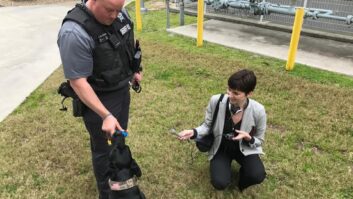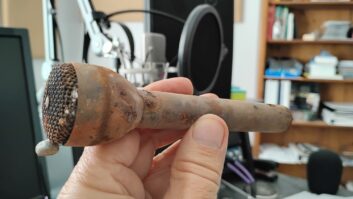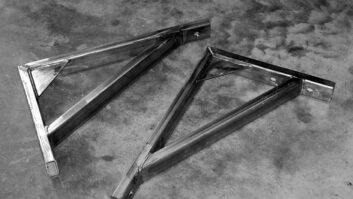Broadcast engineering colleagues became aware this week of the recent death of Emil Torick at age 78.
A scientist and musician, Torick authored more than 60 technical publications and held 16 patents. According to the Santa Barbara News, he died unexpectedly June 19 in his home there. Those with whom he worked and those he influenced remembered his audio innovations, love of music, involvement in the Audio Engineering Society and gentlemanly personality.

“He was the head of CBS Labs; as a VP for CBS he headed Steinway Pianos and Fender Guitars (and was) inventor of the Volumax, Audimax, FMX, to name a few,” consultant David Bialik told Radio World. “Also he was an accomplished player of the violin, who introduced me to the music of Mozart.” Bialik invited Torick to participate in recent panels at AES conventions about loudness and the history of audio processing.
Information in this summary is based on biographical material from AES, the Santa Barbara Music Club newsletter and the Santa Barbara News, as well as RW’s own sources.
During a 28-year career at CBS starting in the late 1950s, Torick held various engineering and executive positions in research and development, product engineering and technology licensing. He was responsible at the CBS Technology Center for the direction of advanced audio research programs on behalf of the CBS Broadcast Group, Columbia Records and the CBS Musical Instruments Division, which included companies like Steinway Pianos and Fender Guitars.
Later he was president and chief operating officer of Broadcast Technology Partners, which was set up by CBS and the National Association of Broadcasters, among others, to license technical improvements in FM radio to the consumer electronics and broadcast industries. He also worked as chief technical advisor on recording technology and digital transmission media for the Recording Industry Association of America, and consulted to the Consumer Electronics Association.
He served on the National Radio Systems Committee; under State Department auspices, he was a member of the U.S. delegation to the International Radio Consultative Committee in Geneva and for 12 years was the U.S. chairman of one of its technical groups. He represented the Eureka-147 Consortium of 14 government and industrial organizations from four European countries in the FCC Inquiry on Digital Audio Broadcasting.
In 1994 he was named president of Technology Base Inc., a company that promised virtual audio products for audio professionals and consumers. Among its products was the Digital Probase processor.
He was long-time president of the AES Educational Foundation as well as a former director of Visage Inc., a manufacturer of interactive video systems. He was assistant concertmaster of the Norwalk Symphony for over 25 years. He performed on violin and organ, and was involved with organizations of chamber musicians, organists and music enthusiasts in Connecticut and California, where he moved in 1997. The Santa Barbara Music Club honored him in 2004 for leading a 16-concert series and has scheduled a concert in October to commemorate him.
Torick was born near Pittsburgh in late 1931. He served as an Air Force officer in Korea and worked as a freelance violinist and organist-choir director; he played with the Pittsburgh Symphony and directed the first televised concert of the Pittsburgh Symphony for the local public television station. A graduate in music from Duquesne University, he also had a BS degree in physics from the University of Pittsburgh and an MBA degree in business administration from the University of Connecticut. He is survived by a son and daughter.
Colleagues remember
Dick Burden told Radio World he recalls meeting Torick in the early 1960s. “His early work in audio processing and the CBS Audimax and Volumax is legend in the broadcast industry. … Emil was a well-known audio engineer, a tireless worker for the AES and a friend.” Omnia founder Frank Foti called him a pioneer of broadcast audio processing. “His efforts predated the paradigm shift when processing became a programming tool as well as modulation controller. I always admired him for his penchant to improve broadcast technology. In the 1980s he developed a method to add dynamic noise reduction to the L–R subchannel of the FM stereo system as a means to combat multipath and transmission noise.”
Greg Ogonowski of Orban said, “I was just on a panel with Emil not long ago. Many of Emil’s designs were my audio processing engineering inspirations that were then improved on for Gregg Laboratories and Orban. The CBS Audimax/Volumax was ‘the force to be reckoned with’ for a long time, and is already down in broadcast history as one of the most popular audio processing systems of the time.”
Torick had a long association with the AES; he was an AES Fellow, honorary member and past president. As AES president in 1977–78, he established the basis for AES technical standards activities and chaired a working group that developed the first standard (for Preferred Digital Sampling Frequencies). He was honored in 2009 with its Distinguished Service Medal for five decades of service to the society and its community.
Executive Director Roger Furness told RW, “Emil Torick was a much liked and appreciated man who served the AES in various positions for many years. For 25 years he had been president of its Educational Foundation, only retiring last year. He will be remembered for his clear thinking and his humor and will be sorely missed by all those who knew him.”
Audio processing innovator Bob Orban told RW, “He was a legend in our industry and one of the people who, at CBS Labs, helped create many of the innovations in broadcast audio broadcasting technology that we take for granted today. I first got to know Emil personally in the early 1980s, when Orban was working on licensing Emil’s and Bronwyn Jones’ loudness controller technology for our television audio processing. I later worked with him when Orban was evaluating the FMX FM stereo noise reduction technology that he helped invent, and was honored to be part of several AES events in which he participated. As well as being a fine engineer, he was a gentleman.”
Radio World is collecting comments and memories of Emil Torick for a future story. E-mail Paul McLane at [email protected].
Related:
Emil Torick Awarded Distinguished Service Medal (2009, PDF)
FMX Technology Sparks Dispute Between Bose and Developers (1989)
Patent, “FM stereophonic system having improved compatibility in presence of multipath”







